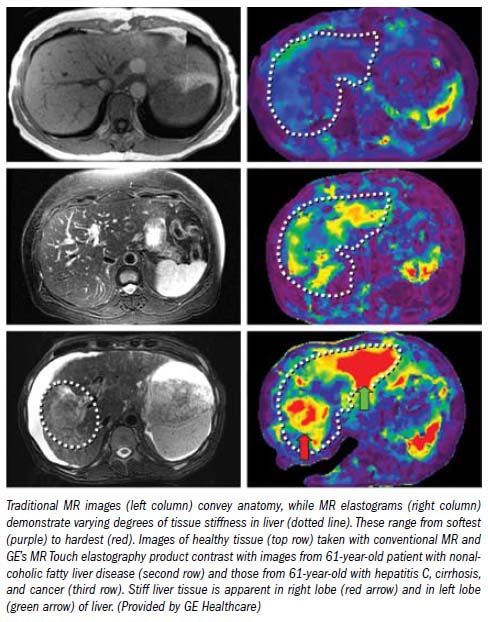MR uncovers cirrhosis with high-tech palpation
The liver is very soft when it's healthy; fibrosis firms the tissue.
The liver is very soft when it's healthy; fibrosis firms the tissue. Cirrhosis makes it rock hard. Half of those patients who progress to this stage are dead within five years with a liver transplant their only hope for survival. MR Touch can detect fibrotic changes when patients still have a good chance of recovering on their own.
The FDA-cleared technology, available from GE Healthcare on the Optima MR450w 1.5T system launched last year, measures the stiffness of liver tissue. It thumps the liver at the end of a routine MR exam with mechanical vibrations that compress the organ, changing the MR signal to indicate the elasticity of tissue. Stiff tissue shows up as red on the MR images. Soft, healthy tissue appears purple.
Such colored images helped physicians at the Mayo Clinic in Rochester, MN, evaluate more than 2000 patients over the last couple of years. Data are acquired in a breath-hold, according to radiology professor Dr. Richard Ehman, who led the team at Mayo that developed the technique, now commercialized by GE as MR Touch.
The underlying research goes back to a paper published in 1995 in the journal Science. In it, Ehman proved that a modified phase contrast technique could image the in vivo effects of mechanical waves, even when they displaced tissue by a micron or less. The last decade has been spent working out the mathematics for quantifying those effects and determining the clinical value of doing so.

The Mayo researchers have shown that tissue stiffness serves as an early warning for patients at risk for cirrhosis of the liver. It can replace the invasive and expensive liver biopsies commonly used to confirm this diagnosis, according to Ehman.
“MR elastography has the advantage of providing a global view of the entire liver and its stiffness,” he said. “By measuring liver stiffness, we can determine whether the patient has fibrosis.”
Its coverage of the entire liver, rather than the slender threads of tissue obtained through biopsy, promises to improve diagnostic accuracy, Ehman said. MR Touch is noninvasive, so it imposes no discomfort and carries none of the risks associated with biopsy, such as the potential for bleeding or even death due to complications. And it promises to cut the cost of healthcare.
“Biopsy is many times as expensive as MRI, but MR elastography doesn't need to be done on its own,” he said. “It can be included in standard MR examinations of the abdomen that are performed to rule out complications of liver disease. It is important to detect fibrosis while it is silent, because many times we can reverse it if we make the diagnosis soon enough.”
GE HealthCare Debuts AI-Powered Cardiac CT Device at ACC Conference
April 1st 2025Featuring enhanced low-dose image quality with motion-free images, the Revolution Vibe CT system reportedly facilitates improved diagnostic clarity for patients with conditions ranging from in-stent restenosis to atrial fibrillation.
The Reading Room Podcast: Current Perspectives on the Updated Appropriate Use Criteria for Brain PET
March 18th 2025In a new podcast, Satoshi Minoshima, M.D., Ph.D., and James Williams, Ph.D., share their insights on the recently updated appropriate use criteria for amyloid PET and tau PET in patients with mild cognitive impairment.